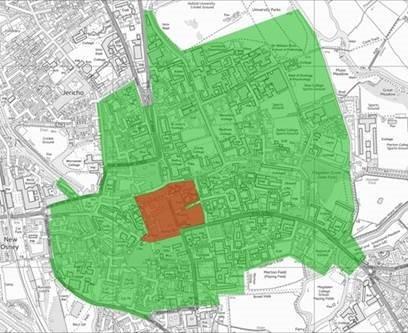OXFORD’S Zero Emission Zone (ZEZ) plans have been scaled back to become ‘more effective and deliverable’.
Previous proposals suggested the zone would see all petrol and diesel taxis, cars and buses excluded from six central streets from 2020.
What will the ZEZ mean for you: your questions answered
But no driving ban is proposed for next year in the latest plans, published by Oxford City Council and Oxfordshire County Council following a 15-month consultation.
Instead, only zero emission capable vehicles will be allowed to park or load in a ‘red’ city centre zone – comprising Cornmarket Street, Queen Street, New Inn Hall Street, St Michael’s Street, Ship Street, and part of Market Street – between 10am and 6pm from next year. An exact date for implementation has not been set.
WHAT WAS THE PREVIOUS PLAN? Details explained here
The latest proposals will also force all taxis licensed in the city to be zero emitting by 2025 and all buses to be low-emitting Euro 6 models by the end of next year.
Taxi companies and drivers will have to fund the change, with one driver set to buy the city’s first electric taxi imminently. Cash has been lined up for 19 electric vehicle charging points in Oxford, which will give priority to the Hackney carriage fleet.
The councils are aiming for a zone excluding all polluting vehicles to be in place by 2037 at the latest. And starting next year, a number of increasingly stringent regulations will ‘begin a journey to zero emissions’.

The updated 'zones' for the ZEZ
Officials insist the zone is still on track to be the world’s first ZEZ. Many of the proposals are yet to be finalised, with the potential penalties and methods of enforcement for breaking regulations remaining unknown.
Emergency vehicles, and disabled blue badge holders look set to be exempt from the regulations, which aim to cut air pollution dramatically, owing to its hugely damaging impact on health.
The World Health Organisation backs the ZEZ in principle, with 274 Oxfordshire deaths were linked to air pollution last year.
READ AGAIN
- World Health Organisation gives backing to Oxford's ZEZ
- ZEZ: Madrid battles Oxford for world's first zero emissions zone
- Oxford plan could hit bus company for millions
But the city council says a 23 per cent reduction in nitrogen dioxide was detected in 2017 – thought to be due to increasing numbers of Euro 6 buses – and the ZEZ is expected to improve pollution county-wide through greener transport to and from Oxford.
City Councillor Tom Hayes, Executive Board Member for A Safer and Greener Environment, said: “Our councils are united in driving down toxic and harmful emissions because we care about the health of Oxfordshire.
“Oxford is proud to be leading the way to zero emissions for cities like London, Paris, and Madrid.”
The plans will be developed and costed this year, with another consultation in autumn. A final decision will need city and county council approval.






Comments: Our rules
We want our comments to be a lively and valuable part of our community - a place where readers can debate and engage with the most important local issues. The ability to comment on our stories is a privilege, not a right, however, and that privilege may be withdrawn if it is abused or misused.
Please report any comments that break our rules.
Read the rules hereLast Updated:
Report this comment Cancel